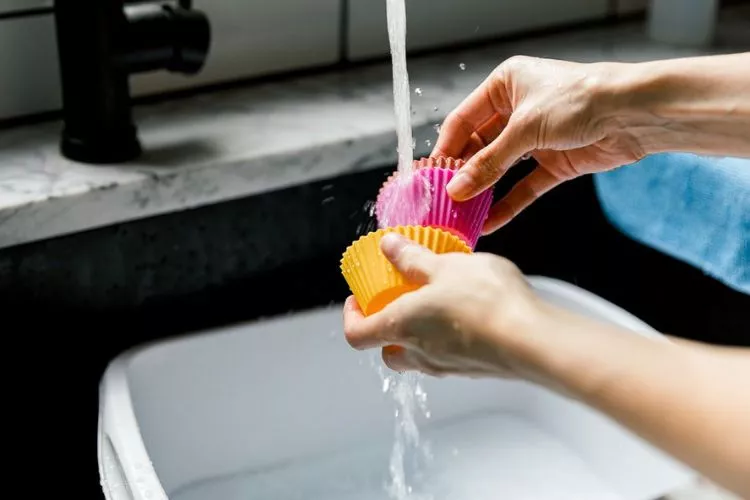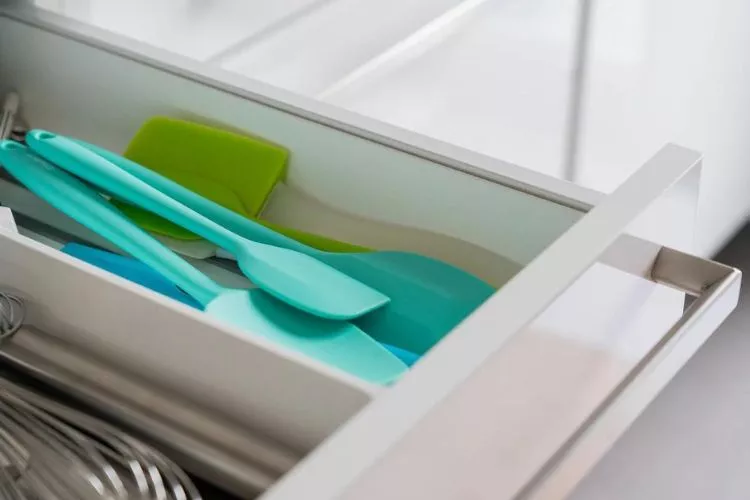Welcome to our in-depth look at the world of silicon-based products and dishwashers. What happens when these two meet?
Silicon items are common in our homes. People use them for cooking and storing food often.
But can silicone go in the dishwasher without trouble? This is a question on many minds yet never fully addressed.
This piece will shed light on this topic.

We will share expert views, results from various tests, and helpful tips. If you have silicone items and a dishwasher, this is must-read content. Find out if your life can get much easier or if caution is needed.
Can silicone go in the dishwasher?
Yes, silicone can go in the dishwasher. Many silicone products are dishwasher safe.
These include bakeware, kitchen tools, and food storage containers. Silicone is resistant to heat.
This makes it safe to use in a dishwasher’s high-temperature setting. But you need to check the product’s label first.
It will tell you if the item is dishwasher safe. Always place silicone items on the top rack of the dishwasher.
This will protect them from direct heat sources. Dishwashers have a heating element at the bottom. Placing silicone items on the top rack minimizes the risk of damage.
Can silicone go in the dishwasher bottom rack?
Silicone items can withstand high temperatures. Many of them are safe to go in the dishwasher.
Yet, it’s best to not place them on the bottom rack. The bottom rack of the dishwasher is the hottest area.

This intense heat may affect silicone items. Placing your silicone items on the top rack is the safer option. It ensures they avoid direct exposure to the hot elements at the bottom.
But it’s important to always check the label of your silicone product. It will tell you if the item is safe to clean in the dishwasher.
How long can silicone go in the dishwasher?
Silicone products are durable, and heat resistant. They can survive many cleaning cycles in the dishwasher. But the specific duration is not easy to pin down.
It depends on a few factors. These include the quality of the silicone product, how often it’s washed, and the dishwasher’s settings.
It’s crucial to check the product’s label. It may provide specific care instructions. Following these will help to extend the product’s lifespan.
Proper loading and placement within the dishwasher are also vital. Silicone items should avoid direct contact with heating elements.
Why is silicone sticky after washing?
Are your silicone utensils feeling sticky after a wash? You’re not alone in this. It frustrates many.
Silicone turns sticky because of several reasons. The main one being the use of harsh detergents. Such detergents can strip away the smooth surface.

Oily foods can also leave residues. These residues stick harder over time, causing a tacky feel. Even dust and grime from the environment can cling.
Sticky silicone is not a lost cause. You can remove the stickiness with warm soapy water.
Gentle brushing helps too. But remember, prevention is better.
You need to clean silicone right after use. Quick removal of food residues will save your silicone items from turning sticky.
How to Clean and Sanitize Silicone?
Cleaning and sanitizing silicone is easy. You need a few common household items.
Here is a step-by-step guide.
- Rinse with Warm Water: Rinse your silicone items with warm water. This act will remove any loose dirt or food particles.
- Use Dish Soap: Put a few drops of mild dish soap onto the silicone item. Rub the soap into the silicone. Be gentle. Use your hands or a soft cloth.
- Cleaning with Baking Soda: Stubborn stains and odors might not go away with just soap. In that case, use baking soda. Make a paste with baking soda and a small amount of water. Apply the paste to the silicone object. Let it sit for a few minutes. Then, gently scrub it off.
- Rinse and Dry: Rinse the item in warm water. Make sure all soap and baking soda are gone. Then, wipe it dry.
- Sanitize in the Oven: For extensive sanitization, place your silicone item in the oven. Keep the temperature at 180 degrees Celsius. Bake for 10 minutes. Stay safe. Never leave your oven unattended.
Remember, silicone requires proper treatment. Use these steps. Keep your silicone items clean and hygienic.
What You Should Not Clean Silicone With?
Silicone items are tough yet flexible. They last a long time if you treat them well. One way to ensure silicone’s longevity is by avoiding certain cleaning agents.
Here’s a short guide on what not to clean silicone with.

- Avoid Harsh Detergents: Stay away from strong cleaning agents. They can damage the silicone’s surface. Stick with mild dish soap.
- No Abrasive Scrubbers: Silicone can be prone to scratches. Don’t use abrasive brushes or steel wool. A soft cloth or a sponge does the job.
- Avoid Bleach: Avoid using bleach. Bleach can discolor or damage silicone. It is too harsh.
- Don’t Use Sharp Objects: Sometimes, food particles stick too hard. You might be tempted to use a knife or a fork. But don’t. Sharp items can puncture the silicone.
- Avoid Extreme Heat: Silicone withstands high temperatures. But extreme heat is not safe. Do not put silicone on an open flame.
Silicone is not hard to maintain. Follow these instructions. Enjoy the longevity of your silicone items.
frequently asked questions (FAQs)
Can silicone molds go in the dishwasher?
Yes, silicone molds can generally go in the dishwasher. This comes from silicone’s heat-resistant properties. It can withstand temperatures up to 500 degrees Fahrenheit. However, remember to check the care instructions of each product. Certain molds might still require hand washing. If the manufacturer allows dishwasher cleaning, place the molds on the top rack, not touching other dishes to ensure thorough cleaning.
Can silicone mats go in the dishwasher?
Silicone mats are typically dishwasher safe. Their heat resistance allows them to endure the high temperatures of a dishwasher’s drying cycle. However, always check the manufacturer’s instructions first. Also, silicone mats can pick up a soap taste if washed in a dishwasher, so rinse well. Lastly, to avoid warping, position them on the top rack of the dishwasher.
Can silicone bibs go in the dishwasher?
Yes, silicone bibs are one of the many silicone products that can be put in the dishwasher. Its resilient and flexible nature handles the dishwasher environment well. Just ensure that the bib is folded open to expose all the surfaces to the water jets. However, always check the product’s care label or manufacturer’s instructions for any specific guidelines.
Can silicone cups go in the dishwasher?
Silicone cups, like most silicone kitchenware, are suitable for dishwasher use. Their durability and heat-resistance allows them to survive the wash and dry cycles. Always remember to place them on the top rack to prevent them from coming into contact with the heating element. Nevertheless, always adhere to the care instructions provided by the manufacturer, as there may be exceptions.
Can silicone straws go in the dishwasher?
Yes, silicone straws can go in the dishwasher. These straws are specifically designed to withstand high and low temperatures. However, given their small size and shape, they can easily be missed by the dishwasher’s water jets. So, it’s a good practice to rinse them first. Some silicone straws also come with cleaning brushes that you can use for a thorough clean prior to dishwasher use.
Conclusion:
Silicone items boast durability and heat resistance. They handle the environment inside a dishwasher.
Most silicone kitchenware like molds, mats, bibs, cups, and straws shine in the dishwasher. Yet, read the product instructions.
They highlight care methods for each item. A small step that ensures longevity.
So, use the dishwasher. Hand washing is an option too. Choose what suits you.
Rest easy when you use silicone. It’s a reliable, dishwasher-safe material.


